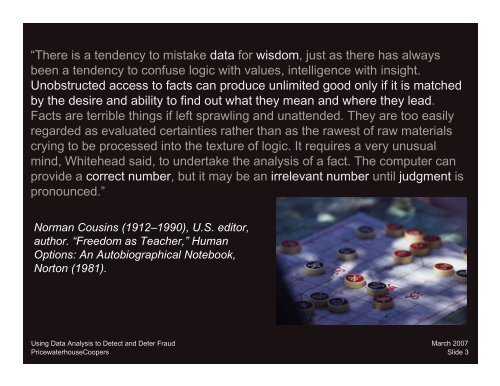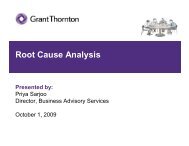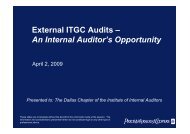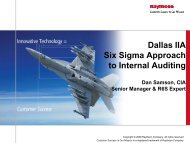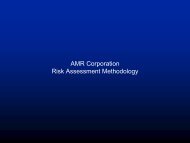Using Data Analysis to Detect Fraud - IIA Dallas Chapter
Using Data Analysis to Detect Fraud - IIA Dallas Chapter
Using Data Analysis to Detect Fraud - IIA Dallas Chapter
Create successful ePaper yourself
Turn your PDF publications into a flip-book with our unique Google optimized e-Paper software.
“There is a tendency <strong>to</strong> mistake data for wisdom, just as there has alwaysbeen a tendency <strong>to</strong> confuse logic with values, intelligence with insight.Unobstructed access <strong>to</strong> facts can produce unlimited good only if it is matchedby the desire and ability <strong>to</strong> find out what they mean and where they lead.Facts are terrible things if left sprawling and unattended. They are <strong>to</strong>o easilyregarded as evaluated certainties rather than as the rawest of raw materialscrying <strong>to</strong> be processed in<strong>to</strong> the texture of logic. It requires a very unusualmind, Whitehead said, <strong>to</strong> undertake the analysis of a fact. The computer canprovide a correct number, but it may be an irrelevant number until judgment ispronounced.”Norman Cousins (1912–1990), U.S. edi<strong>to</strong>r,author. “Freedom as Teacher,” HumanOptions: An Au<strong>to</strong>biographical Notebook,Nor<strong>to</strong>n (1981).<strong>Using</strong> <strong>Data</strong> <strong>Analysis</strong> <strong>to</strong> <strong>Detect</strong> and Deter <strong>Fraud</strong>PricewaterhouseCoopersMarch 2007Slide 3


